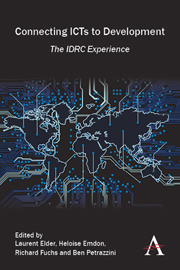Book contents
- Frontmatter
- Contents
- Acknowledgments
- Introduction Part I From Heresy to Orthodoxy: ICT4D at IDRC
- Introduction Part II From Beginning to End to Beginning Again
- Chapter 1 Catalyzing Access through Social and Technical Innovation
- Chapter 2 Catalyzing Access via Telecommunications Policy and Regulatory Research
- Chapter 3 Access to Knowledge as a New Paradigm for Research on ICTs and Intellectual Property
- Chapter 4 ICTs and Social Inclusion
- 5 Access and Usage of ICTs by the Poor (Part I)
- Chapter 6 Local Economic Opportunities and ICTs: How ICTs Affect Livelihoods (Part II)
- Chapter 7 Research on eHealth across Health Systems: Contributions to Strengthen a Field
- Chapter 8 Making the Grade: The Role of ICTs in Providing Access to Knowledge
- Chapter 9 E-Government for Development: ICTs in the Public Sector and the Evolving Citizen–Government Relationship
- Chapter 10 Innovations in Evaluating ICT4D Research
- Chapter 11 Conclusions: A Decade of Innovation that Matters
- Epilogue Into the Future: New Opportunities and Threats in a Global Networked Society
- Author Biographies
Chapter 11 - Conclusions: A Decade of Innovation that Matters
from Introduction Part II - From Beginning to End to Beginning Again
Published online by Cambridge University Press: 05 March 2014
- Frontmatter
- Contents
- Acknowledgments
- Introduction Part I From Heresy to Orthodoxy: ICT4D at IDRC
- Introduction Part II From Beginning to End to Beginning Again
- Chapter 1 Catalyzing Access through Social and Technical Innovation
- Chapter 2 Catalyzing Access via Telecommunications Policy and Regulatory Research
- Chapter 3 Access to Knowledge as a New Paradigm for Research on ICTs and Intellectual Property
- Chapter 4 ICTs and Social Inclusion
- 5 Access and Usage of ICTs by the Poor (Part I)
- Chapter 6 Local Economic Opportunities and ICTs: How ICTs Affect Livelihoods (Part II)
- Chapter 7 Research on eHealth across Health Systems: Contributions to Strengthen a Field
- Chapter 8 Making the Grade: The Role of ICTs in Providing Access to Knowledge
- Chapter 9 E-Government for Development: ICTs in the Public Sector and the Evolving Citizen–Government Relationship
- Chapter 10 Innovations in Evaluating ICT4D Research
- Chapter 11 Conclusions: A Decade of Innovation that Matters
- Epilogue Into the Future: New Opportunities and Threats in a Global Networked Society
- Author Biographies
Summary
The aim of this book is to document and synthesize a special time and space in the business of international development. During the first decade of the new millennium, a major effort was made to assist the developing world to adopt information and communications technologies (ICTs) in their approaches to social and economic development. Canada's International Development Research Centre (IDRC) was a major actor in this endeavor.
As we enter the second decade of the twenty-first century, things have changed dramatically. The mobile phone has become a nearly ubiquitous device, especially in the developing world. With more than six billion mobile phone subscriber accounts in the world, Millennium Development Goal 8f – to increase access to telephone signals by 2015 – has already been met, nearly five years early. Twitter and Facebook are understood to have had major impacts in the transition toward democracy in many parts of the world. The Internet has become an even more important backbone to social development.
None of this happened by accident. Decisions about new telecommunications policies created the environment in which greater competition and accelerated new technology adoption lowered costs, fostered innovation and broadened access to ICTs.
In Africa, for example, a continent with a population smaller than India's but with 53 national governments, this took new knowledge and new institutional capacity in each distinct jurisdiction. In Asia, the most rural continent that is now experiencing accelerated urbanization, it meant the extension of telephony and Internet services far beyond metropolitan area markets and the adoption of new technologies to solve old problems of access in education, healthcare and local government.
- Type
- Chapter
- Information
- Connecting ICTs to DevelopmentThe IDRC Experience, pp. 267 - 278Publisher: Anthem PressPrint publication year: 2013

